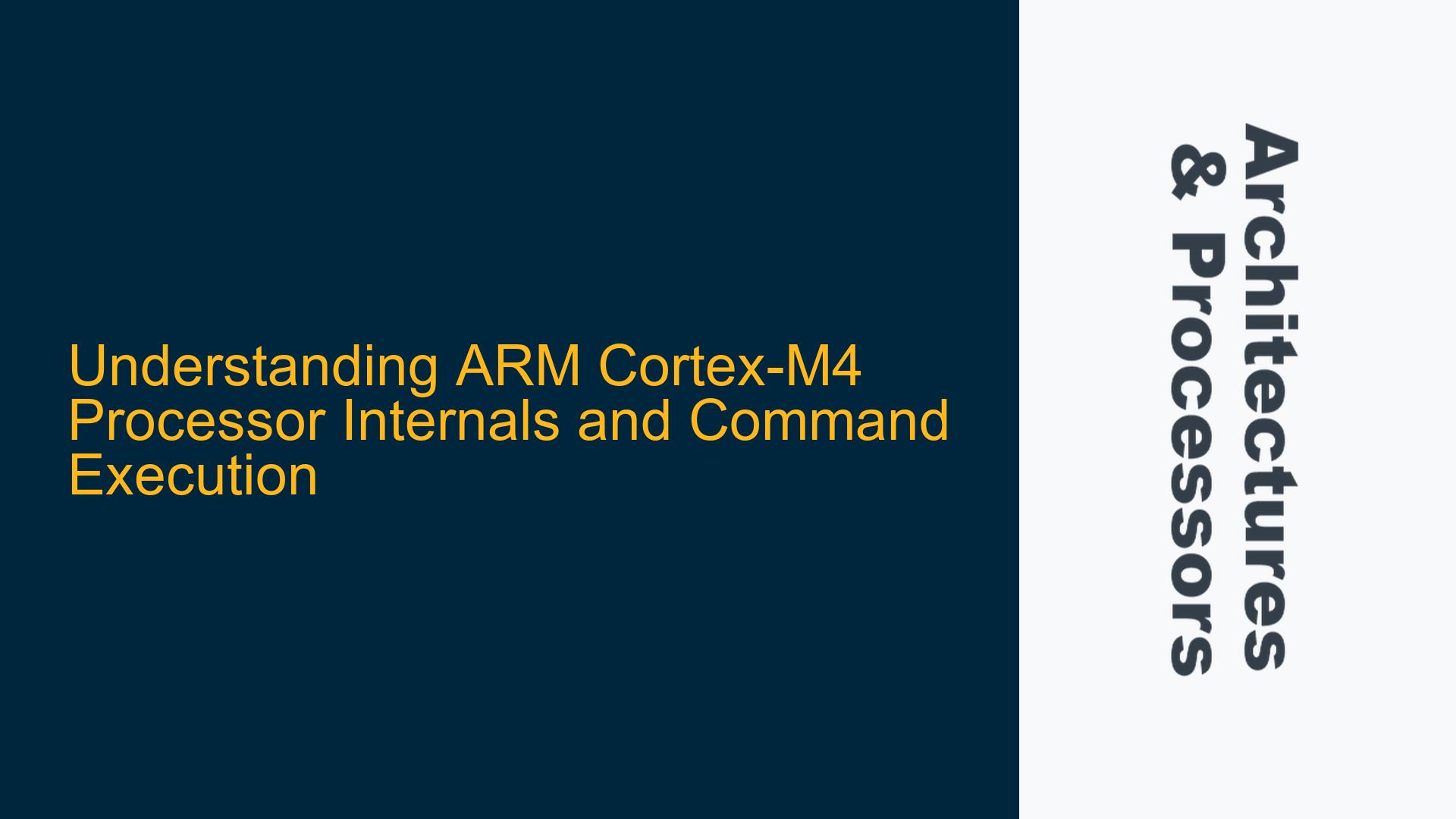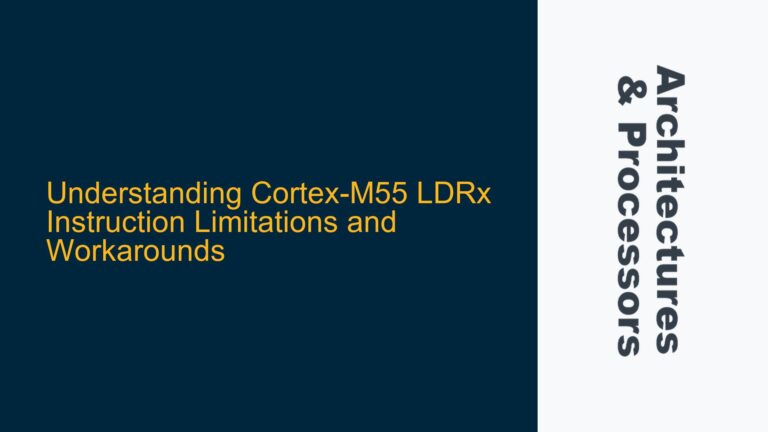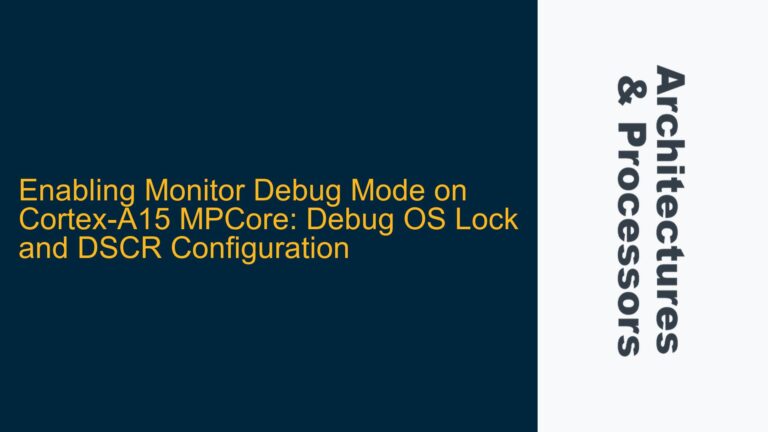ARM Cortex-M4 Processor Architecture and Command Execution Flow
The ARM Cortex-M4 processor is a highly efficient 32-bit RISC processor designed for embedded applications, particularly those requiring digital signal processing (DSP) capabilities. To understand what happens inside the Cortex-M4 when it executes a command, such as changing the color of a smart bulb, we need to delve into its architecture and the sequence of operations that occur during command execution.
The Cortex-M4 processor consists of several key components, including the CPU core, memory system, peripherals, and bus interfaces. The CPU core is the heart of the processor, responsible for executing instructions fetched from memory. The memory system includes Flash memory for program storage and SRAM for data storage, connected via the AHB (Advanced High-performance Bus) and APB (Advanced Peripheral Bus) interfaces. The peripherals, such as GPIOs, timers, and communication interfaces, interact with the external world.
When the Cortex-M4 receives a command, such as changing the color of a smart bulb, the following sequence of events occurs:
-
Instruction Fetch: The processor fetches the instruction from Flash memory via the AHB bus. The instruction is part of the firmware that controls the smart bulb’s behavior.
-
Instruction Decode: The fetched instruction is decoded by the CPU core. The Cortex-M4 uses a 3-stage pipeline (Fetch, Decode, Execute) to process instructions efficiently.
-
Operand Fetch: If the instruction requires data from memory or registers, the processor fetches the necessary operands. For example, the new color value for the smart bulb might be stored in a specific memory location or register.
-
Execution: The CPU core executes the instruction. In the case of changing the color of a smart bulb, this might involve writing a new value to a GPIO port that controls the LED driver.
-
Memory Access: If the instruction involves reading from or writing to memory, the processor accesses the appropriate memory location via the AHB or APB bus. For example, the new color value might be written to a memory-mapped register that controls the LED driver.
-
Peripheral Interaction: The processor interacts with peripherals to execute the command. In the case of a smart bulb, this might involve sending a signal to the LED driver via a GPIO pin or a communication interface like I2C or SPI.
-
Interrupt Handling: If the command execution triggers an interrupt, the processor handles the interrupt by saving the current context, jumping to the interrupt service routine (ISR), and restoring the context after the ISR completes.
-
Pipeline Flush and Refill: If the instruction causes a branch or an interrupt, the pipeline might need to be flushed and refilled with new instructions from the target address.
This sequence of operations is repeated for each instruction in the firmware, allowing the Cortex-M4 to execute complex tasks like changing the color of a smart bulb.
Memory Hierarchy and Cache Management in Cortex-M4
The Cortex-M4 processor features a memory hierarchy that includes Flash memory, SRAM, and optionally, a cache. The memory hierarchy plays a crucial role in the performance and efficiency of the processor, especially when executing commands that involve frequent memory access, such as changing the color of a smart bulb.
The Flash memory stores the firmware, including the instructions that control the smart bulb’s behavior. The SRAM is used for data storage, including variables, stack, and heap. The cache, if present, stores frequently accessed data and instructions to reduce memory access latency.
When the Cortex-M4 executes a command, the following memory-related operations occur:
-
Flash Memory Access: The processor fetches instructions from Flash memory via the AHB bus. The Flash memory access time can be a bottleneck, especially if the firmware is large or the processor is running at a high clock speed.
-
SRAM Access: The processor accesses SRAM for data storage and retrieval. The SRAM access time is typically faster than Flash memory, but it can still impact performance if the data access pattern is not optimized.
-
Cache Management: If the Cortex-M4 has a cache, the processor uses it to store frequently accessed data and instructions. The cache reduces memory access latency by providing faster access to frequently used data. However, cache management is critical to ensure data consistency and avoid cache-related performance issues.
-
Memory Barriers: The Cortex-M4 uses memory barriers to ensure proper ordering of memory operations. Memory barriers are essential in multi-threaded or interrupt-driven applications to prevent data races and ensure consistent behavior.
-
DMA Transfers: The Cortex-M4 can use Direct Memory Access (DMA) to transfer data between memory and peripherals without CPU intervention. DMA transfers can improve performance by offloading data transfer tasks from the CPU, but they require careful management to avoid conflicts with CPU memory access.
-
Memory Protection Unit (MPU): The Cortex-M4 features an optional MPU that can be used to enforce memory access permissions and protect critical memory regions. The MPU is useful in safety-critical applications where memory access violations must be prevented.
Understanding the memory hierarchy and cache management in the Cortex-M4 is essential for optimizing the performance and efficiency of embedded applications, such as controlling a smart bulb.
Debugging and Performance Optimization Techniques for Cortex-M4
Debugging and performance optimization are critical aspects of developing embedded applications on the Cortex-M4 processor. Given the complexity of tasks like changing the color of a smart bulb, it is essential to identify and resolve performance bottlenecks and ensure reliable operation.
-
Debugging Techniques:
- Breakpoints and Watchpoints: Use breakpoints to pause the execution of the firmware at specific points and inspect the processor state. Watchpoints can be used to monitor memory locations and trigger a breakpoint when the memory is accessed.
- Trace and Profiling: Use trace and profiling tools to capture the execution flow and identify performance bottlenecks. Trace tools can provide detailed information about instruction execution, while profiling tools can highlight hotspots in the firmware.
- Semihosting: Use semihosting to interact with the host system during debugging. Semihosting allows the firmware to use the host’s input/output facilities, such as printing debug messages to the console.
- Hardware Debugging: Use hardware debugging tools, such as JTAG or SWD, to connect to the Cortex-M4 and inspect the processor state, memory, and peripherals.
-
Performance Optimization Techniques:
- Code Optimization: Optimize the firmware code to reduce execution time and memory usage. Techniques include loop unrolling, inline functions, and reducing the number of memory accesses.
- Compiler Optimization: Use compiler optimization flags to generate more efficient machine code. The compiler can optimize the code for speed, size, or a balance between the two.
- Memory Optimization: Optimize memory usage by reducing the size of data structures, using efficient data types, and minimizing the use of dynamic memory allocation.
- Cache Optimization: If the Cortex-M4 has a cache, optimize cache usage by aligning data structures to cache lines, using cache-friendly algorithms, and minimizing cache misses.
- DMA Optimization: Use DMA to offload data transfer tasks from the CPU and improve performance. Ensure that DMA transfers are properly synchronized with CPU operations to avoid conflicts.
- Interrupt Optimization: Optimize interrupt handling by reducing the interrupt service routine (ISR) execution time, using nested interrupts, and prioritizing critical interrupts.
-
Reliability and Safety Considerations:
- Error Handling: Implement robust error handling to detect and recover from errors, such as memory access violations or peripheral faults.
- Watchdog Timer: Use a watchdog timer to detect and recover from firmware hangs or infinite loops.
- Memory Protection: Use the MPU to enforce memory access permissions and protect critical memory regions.
- Fault Handling: Implement fault handlers to capture and analyze faults, such as bus faults or usage faults, and take appropriate action.
By applying these debugging and performance optimization techniques, developers can ensure that the Cortex-M4 processor operates efficiently and reliably in embedded applications, such as controlling a smart bulb.
In conclusion, understanding the internal workings of the ARM Cortex-M4 processor, including its architecture, memory hierarchy, and debugging techniques, is essential for developing efficient and reliable embedded applications. By following the detailed steps and considerations outlined in this guide, developers can optimize the performance of their Cortex-M4-based systems and ensure successful command execution, such as changing the color of a smart bulb.






